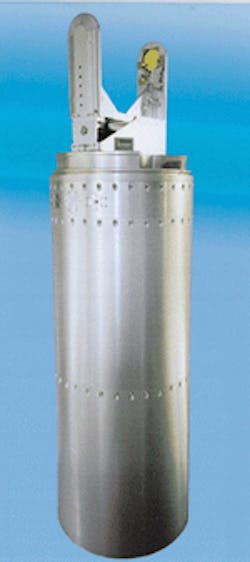Scientists who study the atmosphere want to know how much water vapor exists at high altitudes. Water vapor, after all, is the most important greenhouse gas, and knowing how much is up there helps the scientists determine what roles various gases play in global warming.
The concentration of vapor is also affected by turbulence and convection, so seeing how that concentration varies allows scientists to test atmospheric models. Measurements of carbon dioxide are also important, because while carbon dioxide (CO2) also can cause warming, at certain altitudes it is the most significant cooling mechanism in the air. Though airplanes and balloons have long carried absorption spectrometers to the stratosphere to make such measurements, they have not been able to reach higher.
To make up for the sparse and contradictory data that exist, Franz-Josef Lübken and fellow researchers at the University of Bonn (Bonn, Germany) have designed a device that rides aboard a rocket and takes readings of water (H2O) at altitudes of 50 to 90 km and CO2 at 120 km. Early tests with the middle-atmosphere spectrometric experiment on rockets for analysis of trace-gas influences (MASERATI) have shown the technique to be worthwhile.
The instrument uses a pair of lead-salt diode lasers with a typical output of 100 W. Researchers pick the wavelength of an absorption line for the gas they want to detect—for instance, 4.3 µm for CO2 or 6.5 µm for H2O—and use an optical platform that includes a grating monochromator and a Mach-Zehnder interferometer to determine the laser frequency and timing rate. Another optical platform containing beamsplitters, mirrors, and detectors collimates the laser beams and guides them to the absorption cell.
The multiple-pass absorption setup (not technically a cell, because it is open to the air) uses three spherical concave mirrors (see photo). The beams bounce off these mirrors in 104 passes, so they travel a total optical path of 31.7 m before being guided back to the detector on one of the optical platforms. The mirrors are mounted on various support structures that minimize vibration from the rocket. The CO2 and water vapor are sampled for 7.37 ms each, which corresponds to an altitude resolution of 15 m as the rocket moves through the air.
Approximately 50 s after launch, when the rocket, dubbed RONALD (rocket-borne optical neutral gas analyzer with laser diodes), reaches an altitude of 50 m, a door covering the MASERATI falls away. Also switched on is the transmitter and receiver of laser light (TROLL), which measures atmospheric density by Rayleigh scattering. After about seven and a half minutes, the rocket crashes into the sea.
In the first flight, the door failed to open. On the second attempt, the door worked, and scientists received measurements from MASERATI. Mechanical failures prevented them from recovering either instrument from the ocean. Laboratory tests, though, showed that the instrument could detect a very small relative absorbance of 10-4 to 10-5.
"The good technical performance of the instruments during these flights has demonstrated that MASERATI is indeed a new suitable tool to perform rocket-borne in situ measurements in the upper atmosphere," write Lübken and his colleagues (Applied Optics, 1 Sept. 1999, p. 5340).
About the Author
Neil Savage
Associate Editor
Neil Savage was an associate editor for Laser Focus World from 1998 through 2000.
